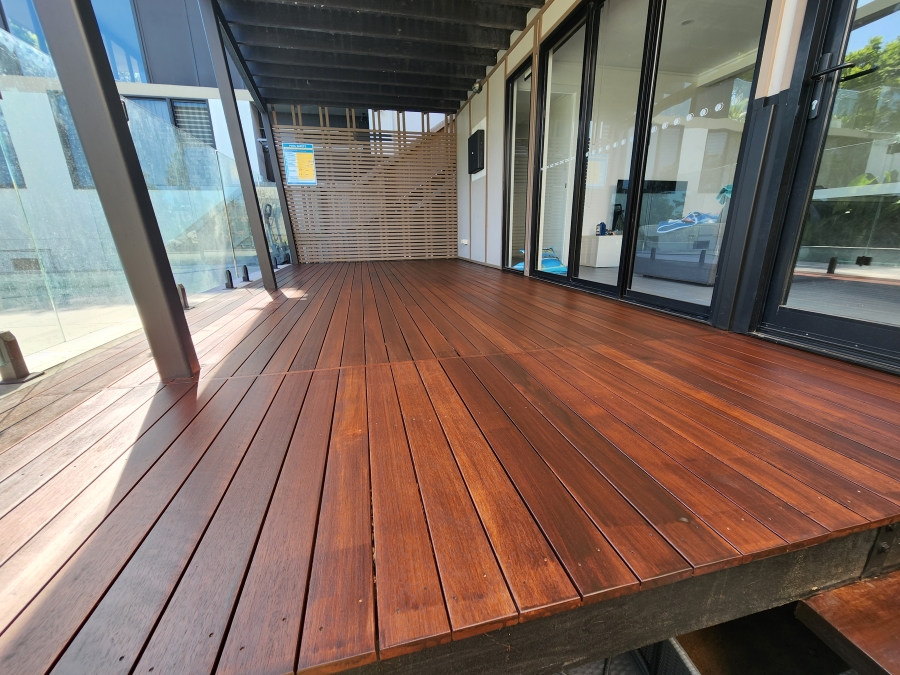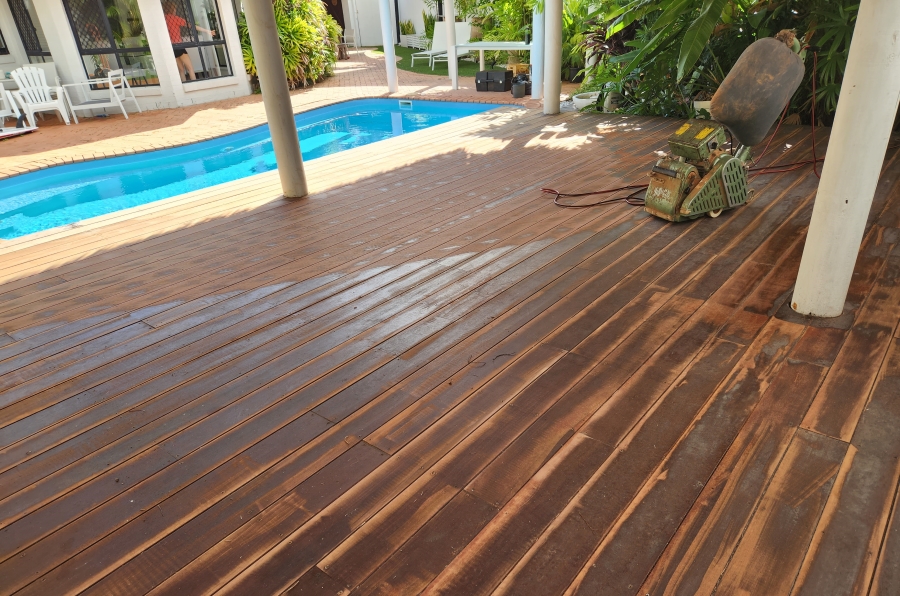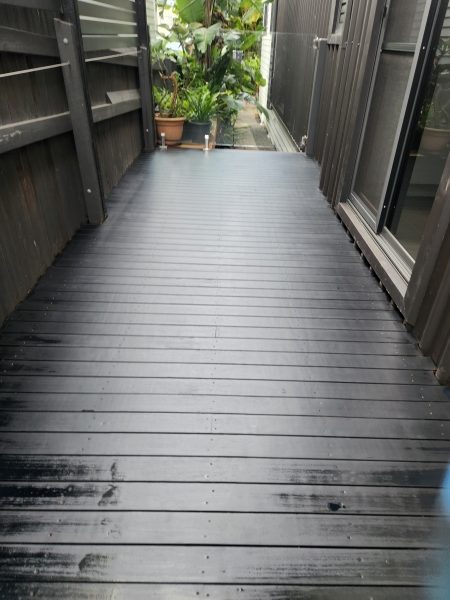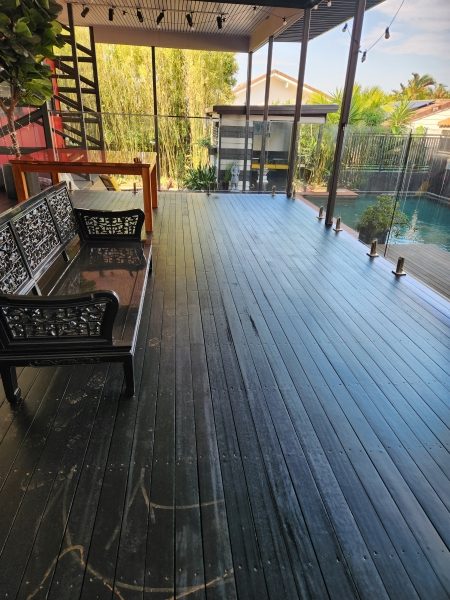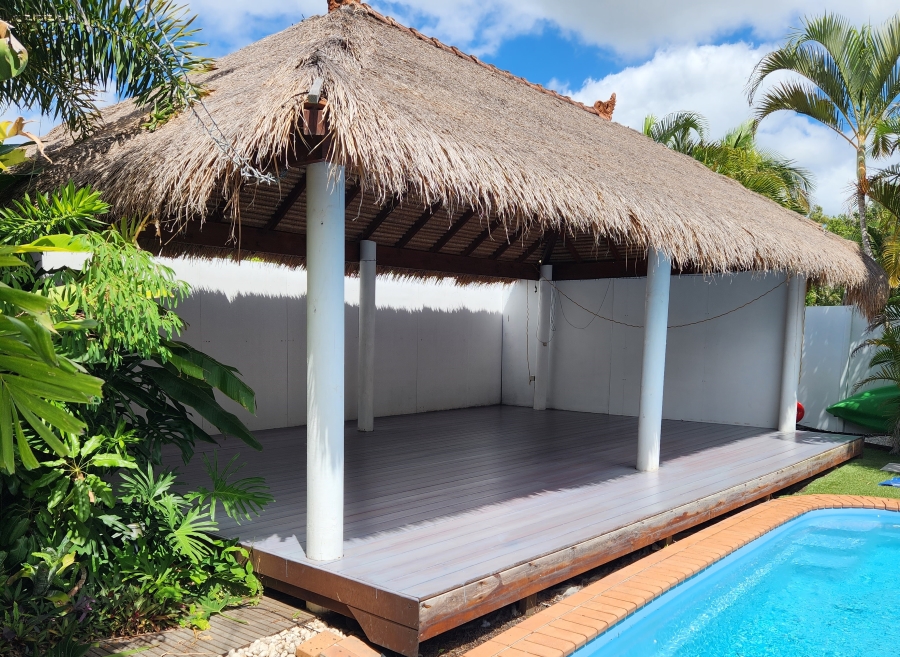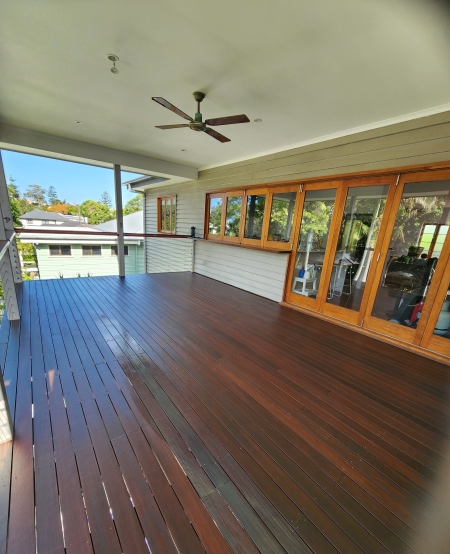Whether you are refinishing or treating your deck for the first time with decking oils or stains, there are processes you need to follow. In this blog, sanding & finishing expert Sharma reveals the products you can use and the process of grinding and coating your decking. This blog lets you distinguish between decking oils and decking stains and discover what will work best for you. He also gives recommendations for the best type of decking to use.
Sanding & Deck Preparation
Before using decking oil or decking stains, there is a bit of preparation work. When working on a freshly built deck or an older one, you first need to go around the deck with a hammer and nail punch. Punch the raised nails or tighten the screws with a screwdriver. This helps prevent deck movement and means you can sand without damaging equipment due to raised nails and screws.
For older decks, sanding usually involves sanding down a greyish, dull & weathered top surface. This should be straightforward work for a sanding machine. Either a belt or a drum sander works well. Because timber generally warps a lot more outside in the direct sun, you are more likely to encounter high and low spots. You cannot expect a deck to be as level as an interior tongue-and-groove floor. In particular, bad cupping or high spots will require more work than a straight, flat surface. Sanding timber floors on the interior can often be more of a process than oil and stain preparation on the outside.
In most cases, a light sanding will be enough to prepare the desired smooth surface for the first coat of stain oil on new or old decks.
Decking Oil vs Stain
There are two main types of deck finishes:
- Decking Oils
- Decking Sealant (Stains)
Decking Oil
Decking oil is a finish that penetrates timber, making it look better and preserving it. It soaks into the wood grain, helps keep moisture out, and helps prevent the negative drying effects of UV exposure. Without any treatment, the decking will rot and age rapidly. Decking oils are available in clear and coloured variations. Note that decking oils are often labelled as decking stains if they contain pigment that alters the timber’s colour.
Benefits
- Regular reapplications rejuvenate colour and stop dry timber’s grey, dull appearance, keeping it looking new.
- Decking oils are more interchangeable because different brands can be combined. They are also more geared towards the DIY market because they are easy to apply and maintain.
- A wide surface area can be efficiently spread per application, meaning less product is needed than deck sealers.
- It contains UV filters to slow UV damage, particularly with tinted variations.
- Rain and moisture-proof
- Replenishes natural oils in the timber, maintaining a fresh, organic look
- Easy application & maintenance, including easy localised maintenance for high foot traffic areas
- Less slippery than other finishes because it allows the timber to keep its natural grip-like texture
Decking Stains & Sealers
Decking stains or acrylic seals sit on top of the timber as a transparent or colour-tinted coat that seals the surface layer and prevents moisture and sun damage. This varnish-like finish prevents fungal growth and rotting wood, prolonging the deck’s life. Deck sealer is great for slowing the effects of water damage but can be more susceptible to harsh UV rays. Often, deck stains are available in a range of wood shades, which can further reduce sun damage to the deck.
Although not always recommended, you can leave deck sealers much longer before they need reapplication, but a lot more work and skill are required when they do. However, even with deck sealer, direct sunlight will dry the wood’s natural oils, leading to fading and cracking. That is why I recommend recoating sooner; preventative measures will ensure you have a healthy-looking & functioning deck for much longer.
Benefits
- It seals the deck with a plastic-like topcoat layer, which is highly durable for foot traffic.
- It [events mould and rot entering via the surface of the deck.
- Colour-pigmented stains can help reduce further UV damage from the sun.
- Decking stains generally dry quickly. They can often be walked on, and furniture can be added back to the deck within a day of application.
- Reapplication may not be needed as frequently as decking oils.
Colours and Tints
Whether you use an oil or a sealant, you can opt for transparent colours, and most products will also have various stained colour options. Generally, even a natural finish may have a slight pigment in it to help guard against UV rays. With darker tints, it is harder to keep the colour even when applying it yourself, and the colour will change more as the sun hits it, which may make it harder to recoat in the future. Light browns are my favourite because they look natural, are easy to apply and match up on recoats.
Remember:
- It is better to stay ahead of schedule regarding retreating your deck regardless of the finish you use. I recommend yearly retreating, which will mean the deck may outlast you.
- Signs of wear and weathering, such as dryness and discolouration around the edges, may indicate that your timber needs a coat.
- A deck with a roof over it will undoubtedly last longer than decking that’s constantly exposed to the sun.
Decking Oil & Stain Application
Applying either decking oil or sealant is very straightforward and should ultimately be directed by supplier guidelines. After the first coats, no minor sand or cutback is generally required.
- A sheepskin or brush decking applicator on a stick is the easiest and most effective way to apply the finish.
- You will need paintbrushes to cut in the edges.
- Decking oil will require more rubbing and working into the timber to soak in.
- With acrylic applicators (sealers), the first layer will be heavier and soak in much more than the lighter application needed for the second layer.
- For timbers such as typical hardwoods Merbau, a couple of coats of either decking oil or sealant will be enough. Keep in mind you will need to reapply a coat after a year.
- Treated pines may soak up more product and require an extra coat.
- The objective for coating is not to flood the product and aim for a nice, even coat.
- Constantly stir the tin well to ensure colours and all ingredients are mixed well.
- Test a small patch first and allow it to dry so you can observe how the dried result will appear.
Drying Time
Oil takes longer to cure and soak into the timber between coats, so you may only be able to apply one coat daily. Acrylic products have a quicker drying time, and you can fit a few coats in one day. Regarding putting furniture back on the surface, suppliers will advise you from 24 hours to a week after the last application regarding when it is safe. Regardless, it is always important to follow the instructions on the side of the tin for the best results.
Weather, temperature, and humidity also significantly affect how long a product takes to dry. The drying process will be slowest in still, cold, and damp weather. A warm breeze will speed up drying time.
Keep Your Deck Looking Like New
Decking oils don’t keep the “new look” for as long as sealants do and require more frequent maintenance to keep the deck looking fresh. However, the good thing about decking oils is that they are easy to maintain. DIYers with no skills can easily use a mop like a decking oil applicator and rub oil on the deck annually with no hassle.
Decking sealants are mostly an acrylic blend, similar to top wear on an engineered floor. Many suppliers recommend maintenance each year. However, most customers contact more every 4 – 5 years for a recoat. Once the sealant wears off, the deck will require resanding before you can recoat, requiring a lot more work than decking oil reapplication. Decking sealants are a lot harder to work with, and people are more likely to hire professional services such as my own to work with them.
Product Recommendation
Sikkens is a brand I regularly use for oils and seal top coats. Although their oil-based product Centol Hlse can be used as a stand-alone decking oil, it can also be used as a base coat for Sikkens Centol Deck, a top coat. This system effectively gives you the best of both worlds with maximum protection for your timber. However, as soon as the surface coat wears off, it will require resanding and refinishing like a typical sealant. In my experience, most customers won’t do it this way, and that can be a shame because it works well.
Another brilliant option for consideration is a product such as Ultra Deck, which combines surface coat acrylic polyurethane and oil.
Choosing a Suitable Timber for a New Deck
I felt this blog post couldn’t be complete without giving some recommendations and guidance regarding timbers you can use for your decking:
Treated Pine
Years ago, there was a period when using treated pine was a popular choice. Affordability and availability certainly played a massive part in this. Even when pine is treated to protect against the outside elements, I believe there are better choices for decking. It is very porous and will soak up, allowing moisture to come in and cause long-term problems such as rot. It will also soak product meaning, extra coat, and maintenance work. So you may spend more on something that doesn’t look good in the long run.
Merbau
It is becoming much more popular and covers a large percentage of new decks built. It is a versatile solid timber and is naturally oily. Its self-treating and natural makeup has made it resistant to rot and corrosion for decades. Moisture has little effect on it compared to other timbers. It has a striking appearance and is available in various shades and colours. It is one of the best-looking and long-lasting options for your deck.
Tallowwood
I have sanded tallowwood decking, which has been there for over 100 years and has not received maintenance for 30+ years. It’s is still in fantastic condition and looks beautiful after I have sanded and treated it. Tallowwood is a personal favourite of mine, and I highly recommend it for decking timber.
It is also high in natural oils with high tannin levels, making it resistant to decay. It makes the perfect decking around the swimming pool or wet environment.
Jarrah
Mostly from Western Australia, it is a beautiful red hardwood that is great for decking. It is highly resistant to termites and comes in various natural colours. I would consider it one of the best-looking timbers on a deck. It is not as oily as other decking timbers, but when sanded and oiled, it can look amazing. It can be a showpiece for decades.
Send us Your Project Photos
Please send us finished photos of your DIY deck finishing or timber flooring project. We would love to see before, during and after shots. We can showcase your handy work on our social media or blog.


